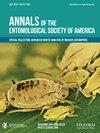五种蝽科(半翅目)唾液蛋白表达谱
IF 1.8
3区 农林科学
Q1 ENTOMOLOGY
引用次数: 0
摘要
臭虫(半翅目:蝽科)的发育通常需要以多种植物物种和各种植物组织为食。在取食过程中,臭虫分泌唾液酶,在口外消化和对抗植物防御反应中发挥作用。虽然以前的研究已经描述了臭虫的消化唾液蛋白,但对抑制植物防御的唾液蛋白知之甚少。我们对从华盛顿非作物生境收集的5种臭虫的唾液腺转录组进行了测序:Halyomorpha halys (stamatl)、Nezara viridula L.、Euschistus conspersus (Uhler)、Thyanta pallidovirens (stamatl)和chlorchroa ligata (Say)。我们从5个物种的唾液腺中共鉴定出677个候选分泌蛋白。基于其他昆虫的工作,许多蛋白质在抑制植物防御信号和植物防御分子失活方面具有潜在的功能。我们还发现唾液蛋白在植物组织的口外消化、昆虫病原体保护和唾液鞘沉积中具有潜在的作用。本报告为进一步的功能分析提供了推测的唾液效应基因。本文章由计算机程序翻译,如有差异,请以英文原文为准。
Salivary protein expression profiles of five species of Pentatomidae (Hemiptera)
Stink bug (Hemiptera: Pentatomidae) development typically requires feeding on a diversity of plant species and various plant tissues. During feeding, stink bugs discharge salivary enzymes with roles in extraoral digestion and countering plant defense responses. Although previous research has described digestive salivary proteins from stink bugs, less is known of the salivary proteins involved in the suppression of plant defenses. We sequenced the transcriptomes of salivary glands dissected from five stink bug species collected from non-crop habitats in Washington: Halyomorpha halys (Stål), Nezara viridula L., Euschistus conspersus (Uhler), Thyanta pallidovirens (Stål), and Chlorochroa ligata (Say). We identified a total of 677 candidate secreted proteins from the salivary glands of the five species. Based on work from other insects, many of the proteins have potential functions in the suppression of plant defense signaling and deactivation of plant defense molecules. We also identified salivary proteins with potential roles in the extraoral digestion of plant tissues, protection from entomopathogens, and deposition of salivary sheaths. This report provides a curation of putative salivary effector genes for further functional analysis.
求助全文
通过发布文献求助,成功后即可免费获取论文全文。
去求助
来源期刊
CiteScore
4.90
自引率
0.00%
发文量
25
审稿时长
6-12 weeks
期刊介绍:
The Annals of the Entomological Society of America exists to stimulate interdisciplinary dialogue across the entomological disciplines and to advance cooperative interaction among diverse groups of entomologists. It seeks to attract and publish cutting-edge research, reviews, collections of articles on a common topic of broad interest, and discussion of topics with national or international importance. We especially welcome articles covering developing areas of research, controversial issues or debate, and topics of importance to society. Manuscripts that are primarily reports of new species, methodology, pest management, or the biology of single species generally will be referred to other journals of the ESA. The most important criteria for acceptance are quality of work and breadth of interest to the readership.

 求助内容:
求助内容: 应助结果提醒方式:
应助结果提醒方式:


